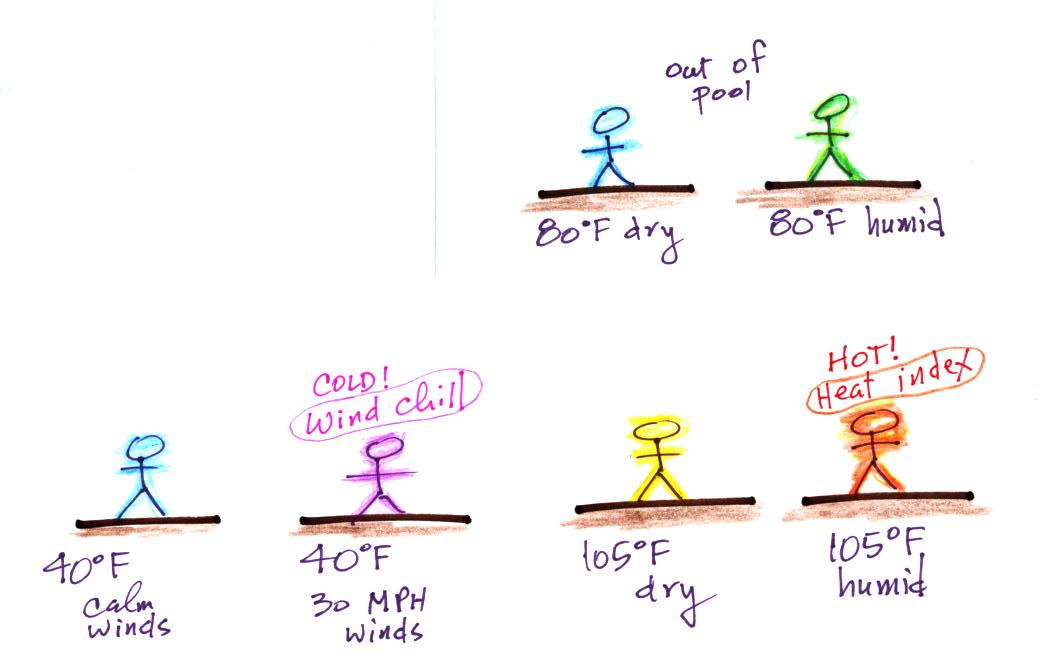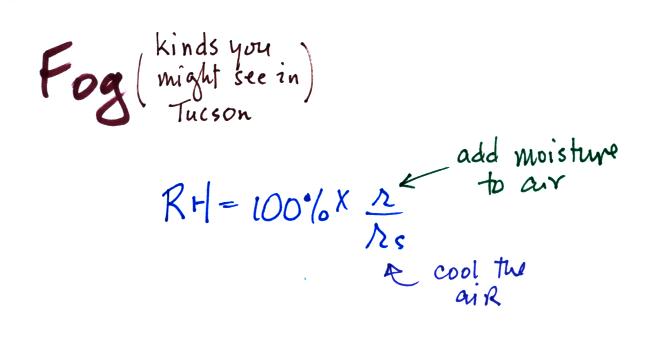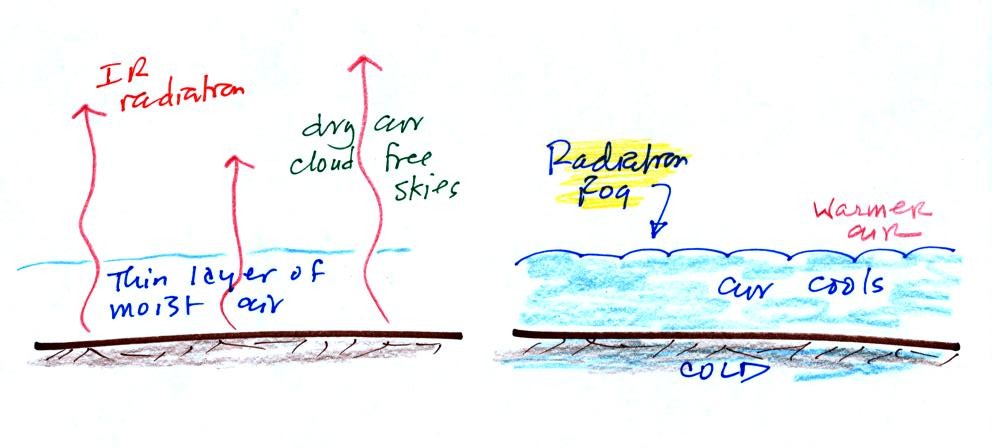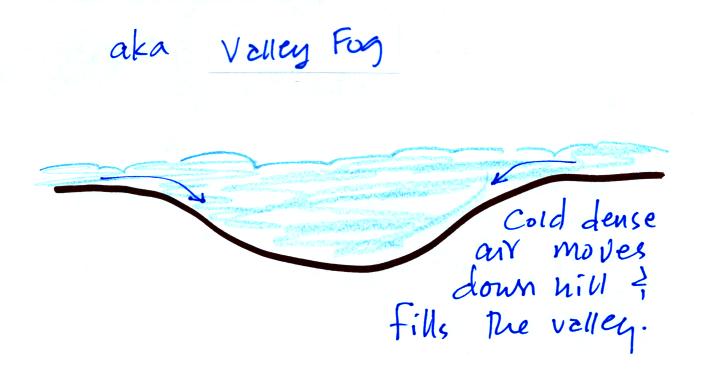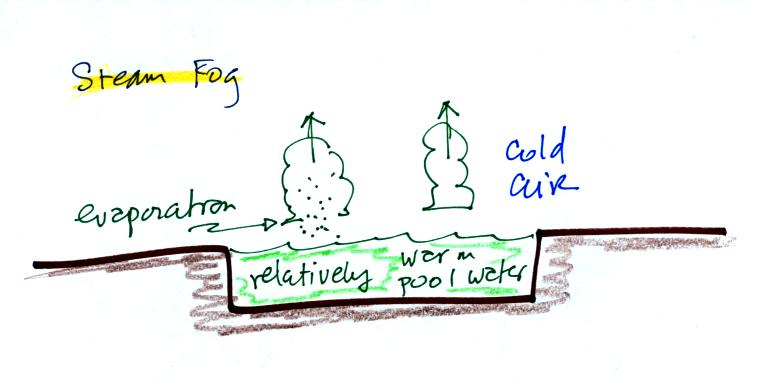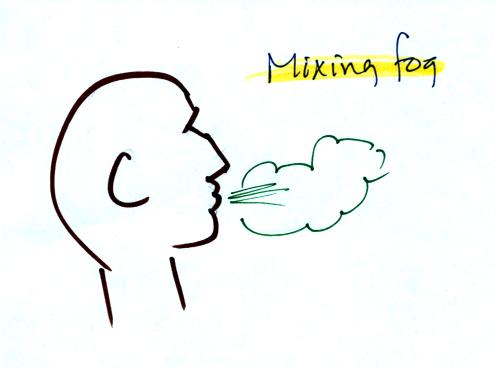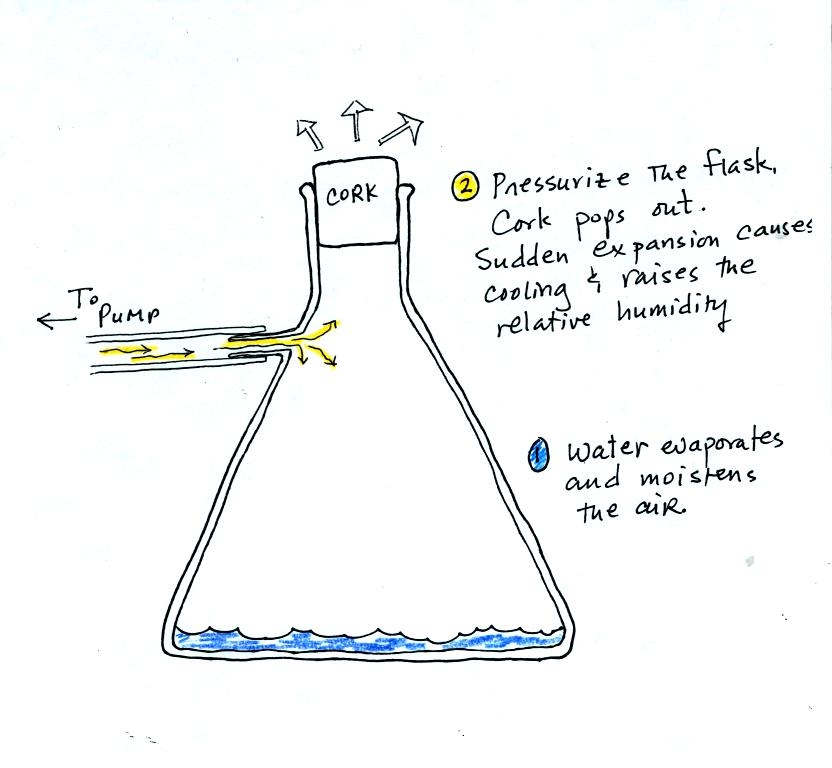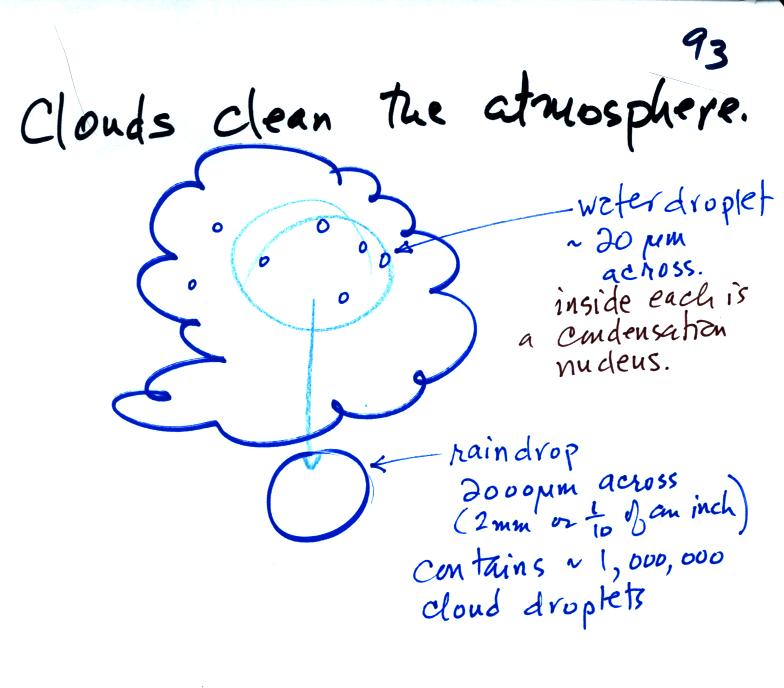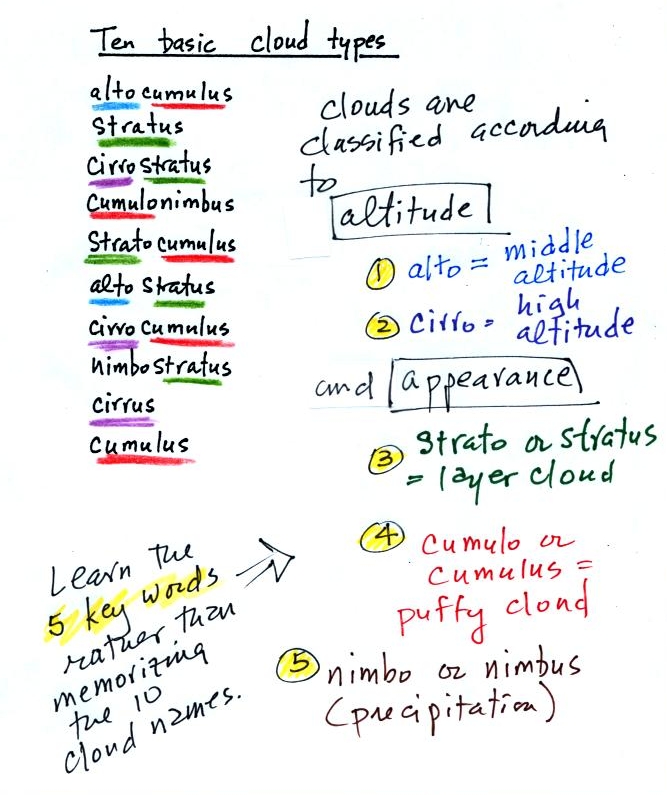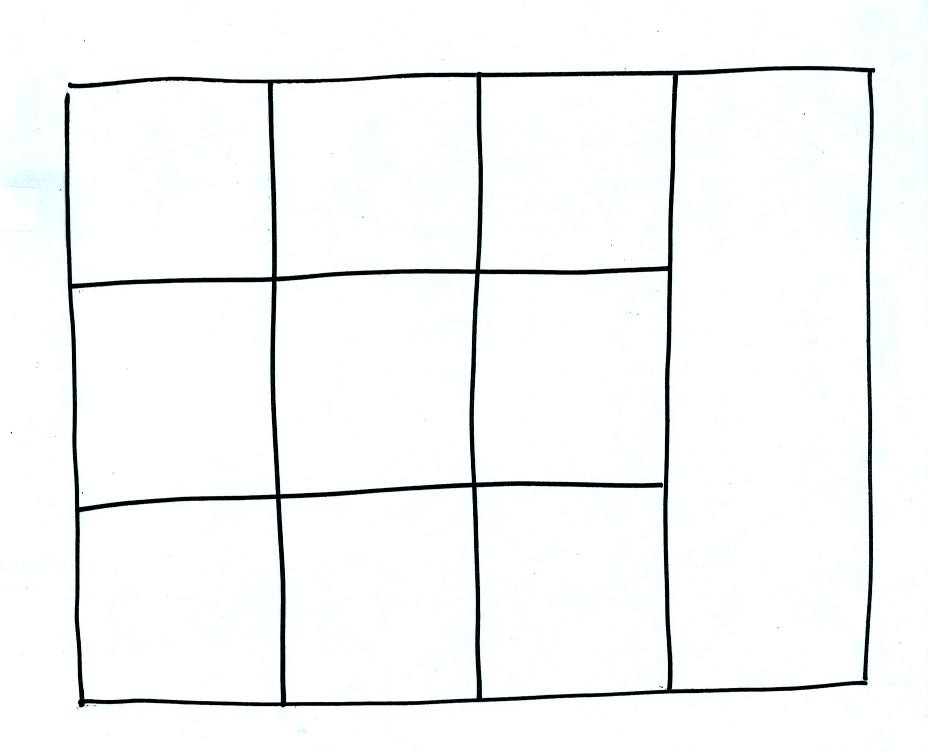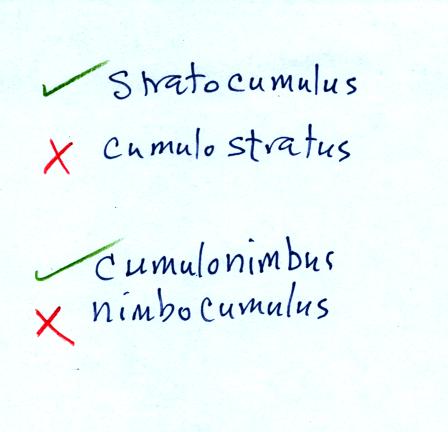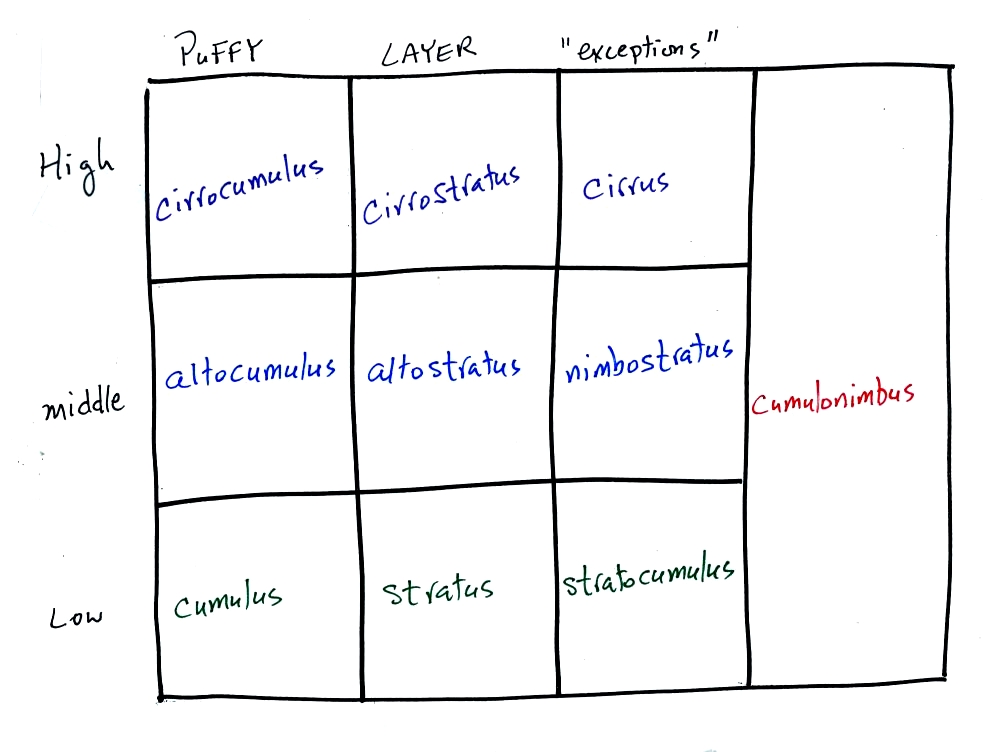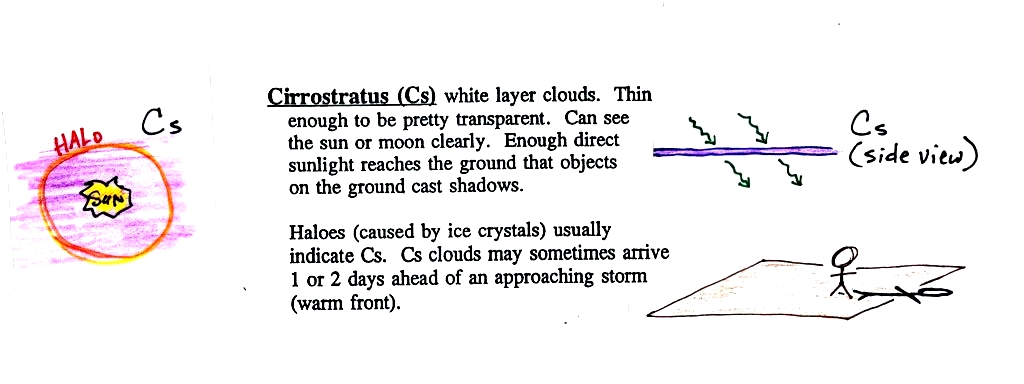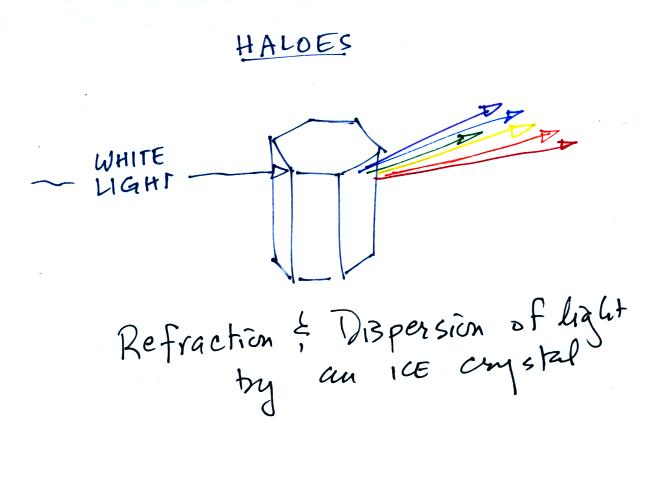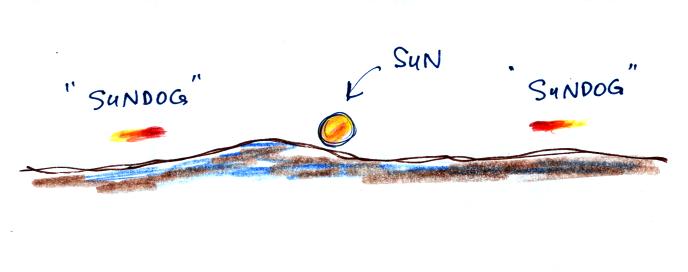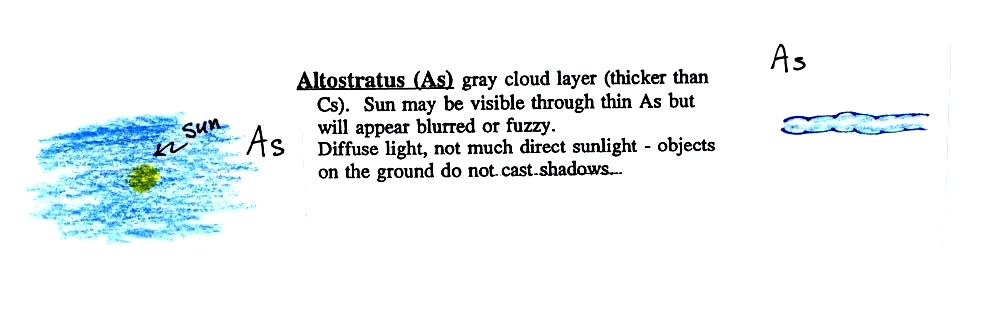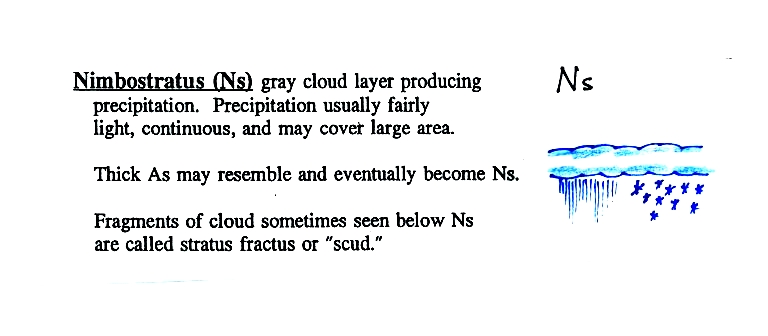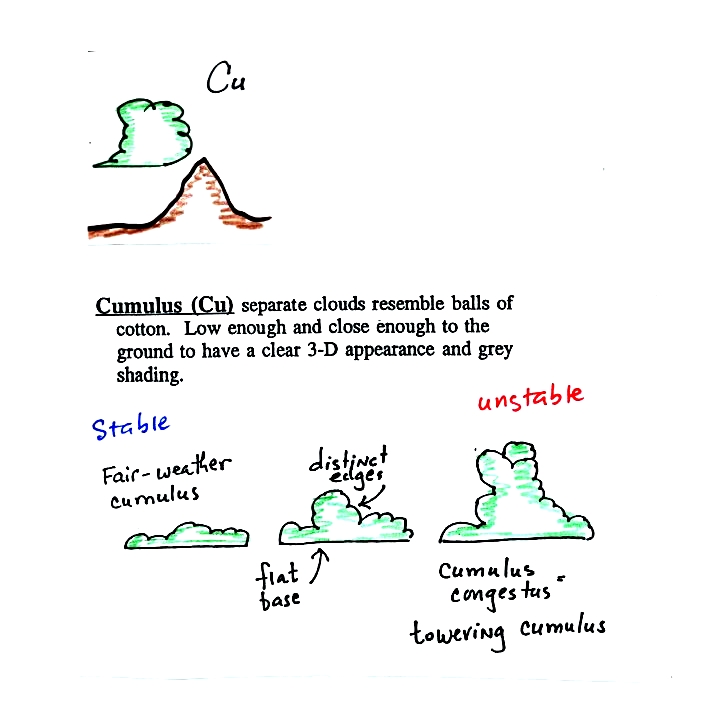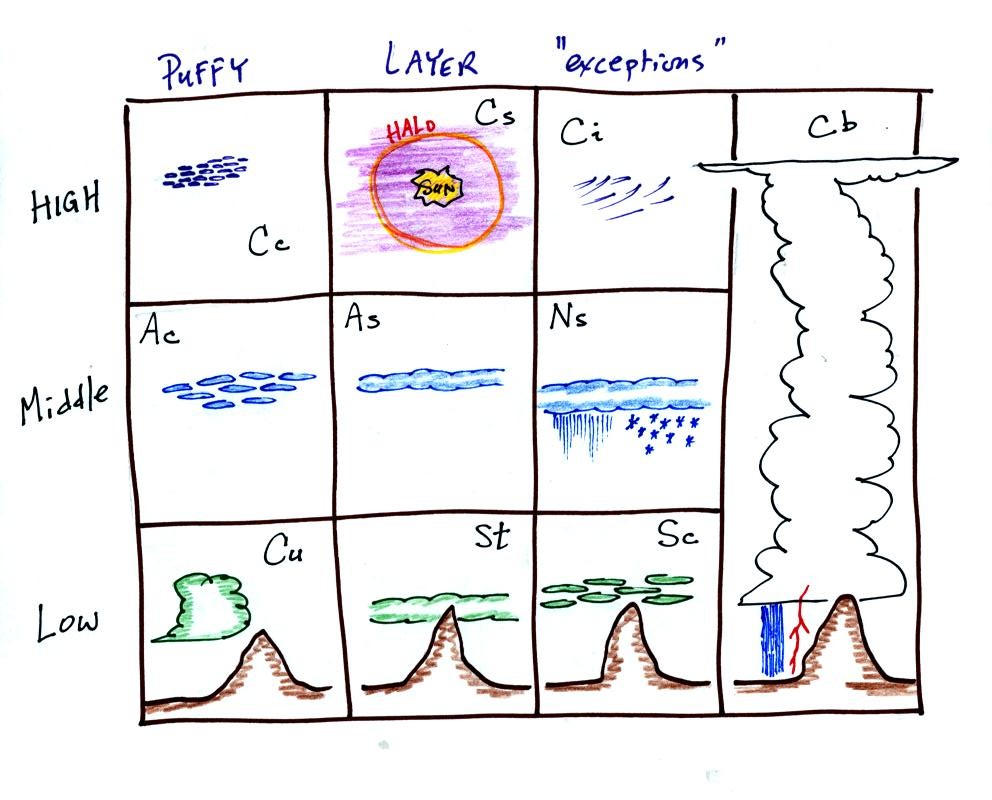The
demonstration was repeated an
additional time with one
small
change. A burning match was dropped into the
bottle. The smoke from the match added lots of very small
particles, condensation nuclei, to the air in the flask. The
cloud that formed
this time was quite a bit "thicker" and much easier to see.
Clouds are one of
the best ways of cleaning the atmosphere
Cloud
droplets (water droplets) form on particles, the droplets "clump"
together to form a
raindrop, and the raindrop carries the particles to the ground).
A raindrop typically contains 1 million cloud droplets, so a
single raindrop
can remove a lot of particles from the air. You may have noticed
how clear the air seems the day after a rainstorm; distant mountains
are crystal clear and the sky has a deep blue color. Gaseous
pollutants can dissolve in the water droplets and be carried to
the ground by rainfall also.
Two small
plastic petri dishes that were passed around class. One contained
granulated sugar, the other powdered sugar. You were supposed to
look at them and determine which one look whitest. I'll see if I
can't take a photograph of them and insert the picture into the class
notes. This difference in appearance is related to the next and
last topic in this section.
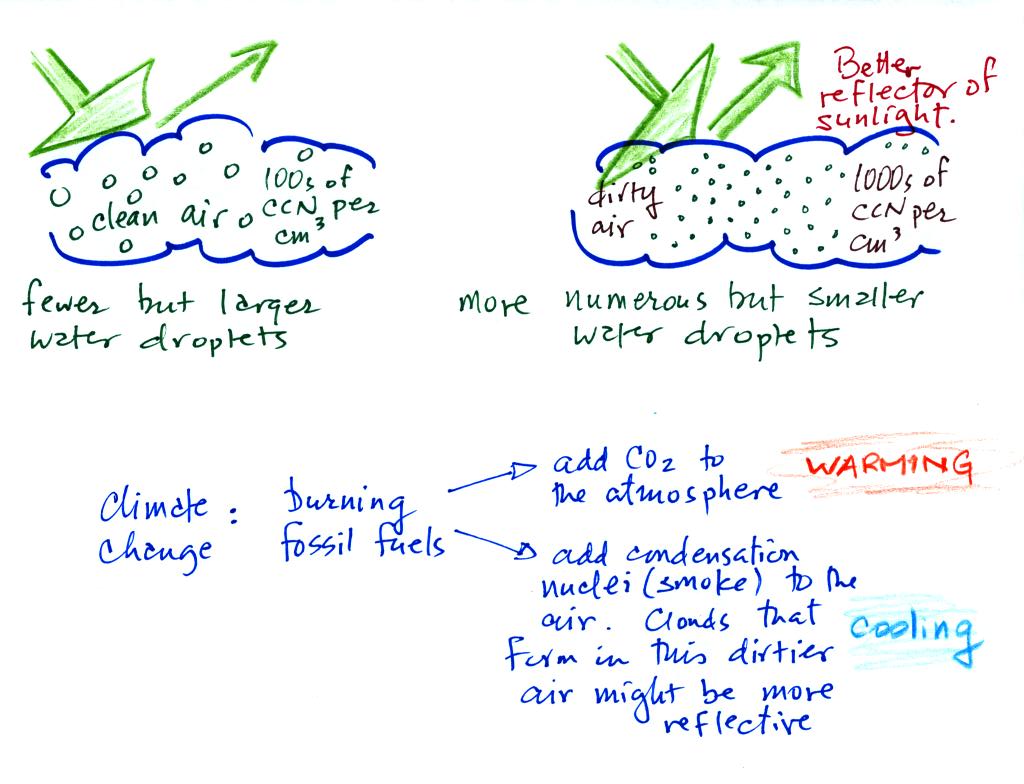
This is has implications for climate change.
Combustion of fossil fuels adds carbon dioxide to the atmosphere.
There is concern that increasing carbon dioxide concentrations will
enhance the greenhouse effect and cause global warming.
Combustion also adds condensation nuclei to the atmosphere (just like
the burning match added smoke to the air in the flask). More
condensation nuclei might make it easier for clouds to form, might make
the clouds more reflective, and might cause cooling. There is
still quite a bit of uncertainty about how clouds might change and how
this
might affect climate (remember too that clouds are good absorbers of IR
radiation).
The remainder of today's class was
devoted to
learning how to identify
and name clouds. The ten main cloud types are listed below
(you'll find this list on p.
95 in
the photocopied class notes).
You should try to learn these 10 cloud
names. Not just because
they might
be on a quiz (they will) but because you will be able to impress your
friends
with your knowledge. There is a smart and a not-so-smart way of
learning
these names. The not-so-smart way is to just memorize them.
You
will inevitably get them mixed up. A better way is to recognize
that all
the cloud names are made up of key words. The 5 key words tell
you something about the cloud's altitude and appearance.
Drawing a chart like this on a blank
sheet of
paper is a good way to
review
cloud identification and classification.
There are 10 boxes in this chart, one
for each of the 10 main cloud types. You should be able to
put a cloud name, a sketch, and a short written description in each
square.
Clouds are classified
according to the altitude at which they form and
the
appearance of the cloud. There are two key words for altitude and
two key
words for appearance.
Clouds are grouped into one of three altitude
categories: high, middle
level,
and low. It is
very hard to just look up in the sky and determine a cloud's
altitude. You will need to look for other clues to distinquish
between high and middle altitude clouds. We'll learn about some
of the
clues when we look at cloud pictures later in the class.
Cirrus or cirro
identifies a high altitude
cloud. There are three types of clouds found in the high altitude
category..
Alto in a cloud name means the cloud is found at middle altitude.
The
arrow connecting altostratus and nimbostratus indicates that they are
very
similar. When an altostratus cloud begins to produce rain or snow
its
name is changed to nimbostratus. A nimbostratus cloud is also
often somewhat
thicker and lower than an altostratus cloud. Sometimes it might
sneak into the low altitude category.
There is no key word for low altitude clouds. Low altitude clouds
have
bases that form 2 km or less above the ground. The summit of Mt. Lemmon in the Santa Catalina mountains
north of Tucson is about 2 km above the valley floor. Low altitude clouds will have bases that form at or
below the
summit of Mt. Lemmon.
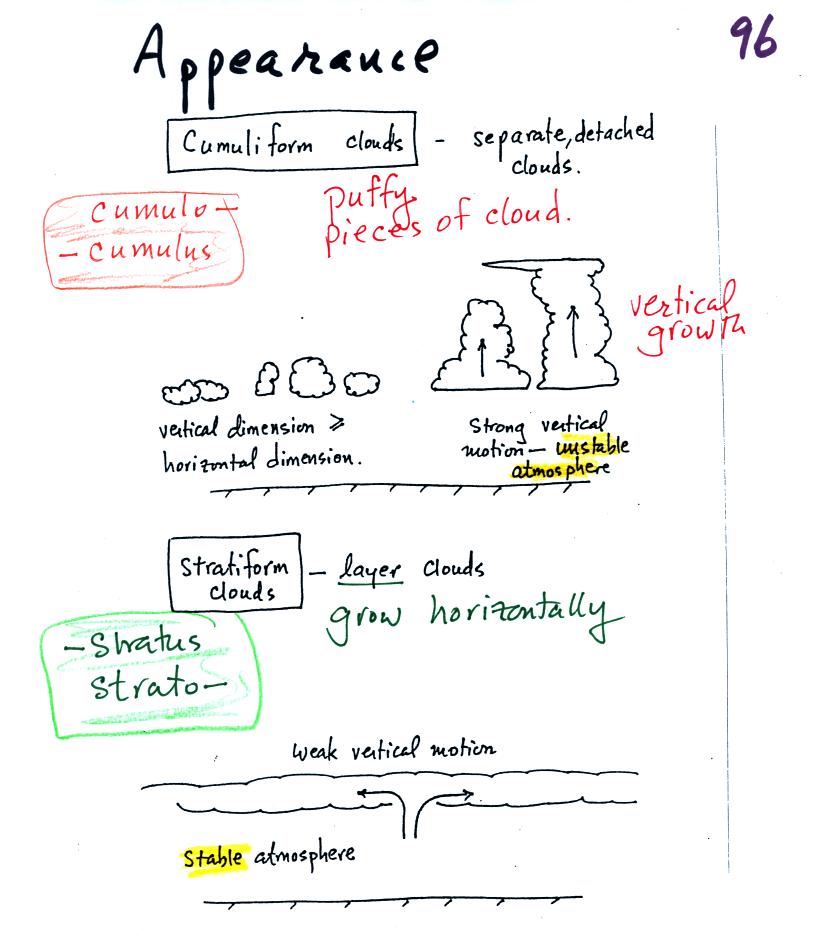
Clouds can have a patchy of puffy (or lumpy,
wavy, or ripply) appearance.
These
are cumuliform clouds and will have cumulo
or cumulus
in their name. In an unstable atmosphere cumuliform clouds will
grow vertically.
Strong thunderstorms can produce dangerous severe weather.
Stratiform clouds grow horizontally and
form
layers. They form when the atmosphere is stable.

The last key word, nimbo
or nimbus, means
precipitation. Only two of the 10 cloud types are able to produce
(significant
amounts of) precipitation. It's not as easy as you might think to
make precipitation.
Nimbostratus clouds tend to produce
fairly light precipitation over a
large
area. Cumulonimbus clouds produce heavy showers over localized
areas. Thunderstorm clouds can also produce hail, lightning, and
tornadoes. Hail would never fall from a
Ns
cloud.
While you are still learning the cloud names you might put the correct
key
words together in the wrong order (stratonimbus
instead of nimbostratus or nimbocumulus
instead of
cumulonimbus). You won't be penalized for those kinds of errors
in this
class because you are putting together the right two key words.
Here's
the cloud chart from earlier. We've added the three altitude
categories
along the vertical side of the figure and the two appearance categories
along
the top. By the end of the class we will add a picture to each of
the
boxes.
Next
we looked at 35 mm slides of most of the 10 cloud types.
You'll find the
written
descriptions of the cloud types in the images below on pps
97-98 in the photocopied notes.
High altitude clouds
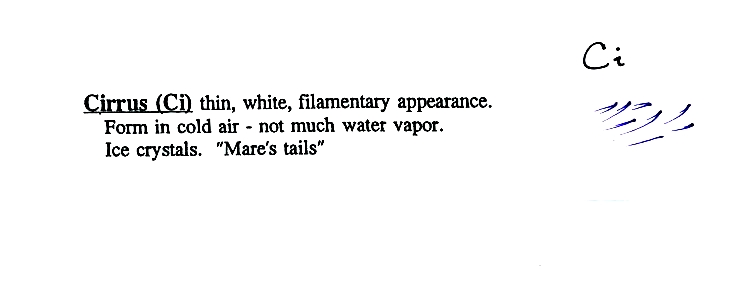
High altitude
clouds
are thin
because the air at high altitudes is very cold and cold air can't
contain much
moisture (the saturation mixing ratio for cold air is very
small). These
clouds are also often blown around by fast high altitude winds.
Filamentary means "stringy" or "streaky". If you
imagine trying to paint a Ci cloud you
would dip a
small pointed brush in white paint brush it quickly and lightly across
a blue
colored canvas.
A
cirrostratus cloud is a thin uniform white layer cloud (not purple as
shown in
the figure) covering part or all of the sky. They're so thin you
can
sometimes see blue sky through the cloud layer. Haloes are a
pretty sure
indication that a cirrostratus cloud is overhead. If you were
painting Cs
clouds you could dip a broad brush in white paint (diluted perhaps with
water)
and then paint back and forth across the canvas.
Haloes
are
produced by
white light
entering a 6 sided ice crystal is bent (refraction). The amount
of
bending depends on the color (wavelength) of the light
(dispersion). The
white light is split into colors just as light passing through a glass
prism. Crystals like this (called columns) tend to be randomly
oriented in the air. That is why a halo is a complete ring around
the sun or moon.
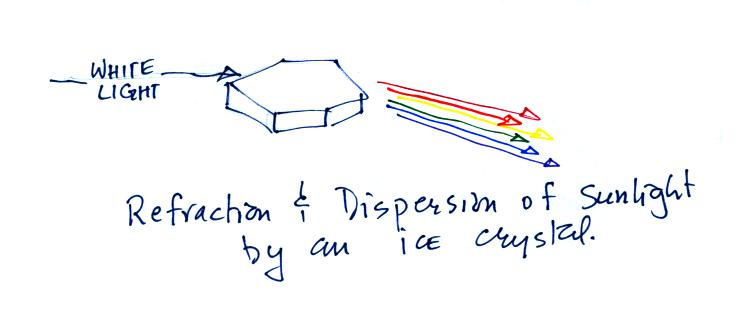
This is a flatter crystal and is
called a plate. These crystals
tend to
all be horizontally oriented and produce sundogs which are only a
couple of small sections of a complete halo. A sketch of a
sundog is
shown below.
Sundogs are
pretty
common and are
just patches of light seen to the right and left of the rising or
setting sun.
If you spend enough time outdoors looking up at the sky you will
eventually see all 10 cloud types. Cirrus and cirrostratus clouds
are fairly common. Cirrocumulus
clouds are
a little more unusual. The same is true with animals, some are more commonly
seen than others.

To
paint a Cc cloud you would dip a sponge in white paint and press it
gently
against the canvas. You would leave a patchy, splotchy appearing
cloud
(sometimes you might see small ripples). It is the patchy (or
wavy)
appearance that makes it a cumuliform cloud.
middle
altitude
clouds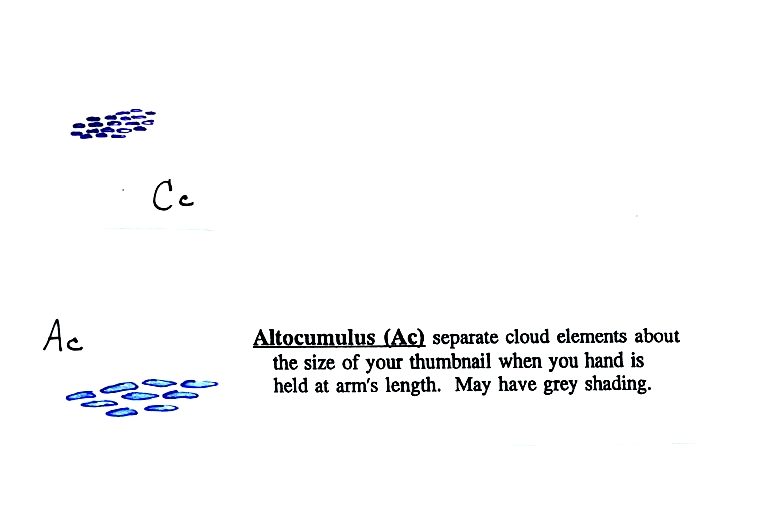
Altocumulus
clouds
are
pretty
common.
Note since it is
hard to
accurately judge altitude, you must rely on cloud element size
(thumbnail size
in the case of Ac) to determine whether a cloud belongs in the high or
middle
altitude category. The cloud elements in Ac clouds appear
larger
than in Cc because the cloud is closer to the ground.
Altostratus
clouds are
thick
enough that you probably won't see a shadow if you look down at your
feet. The sun may or may not be visible through the cloud. When (if) an altostratus cloud begins to produce
precipitation, its
name is changed to nimbostratus.
This cloud name
is a
little
unusual because the two key words for cloud appearance have been
combined. Because they are closer to the ground, the separate
patches of
Sc are about fist size. The patches of Ac, remember, were about
thumb
nail size.
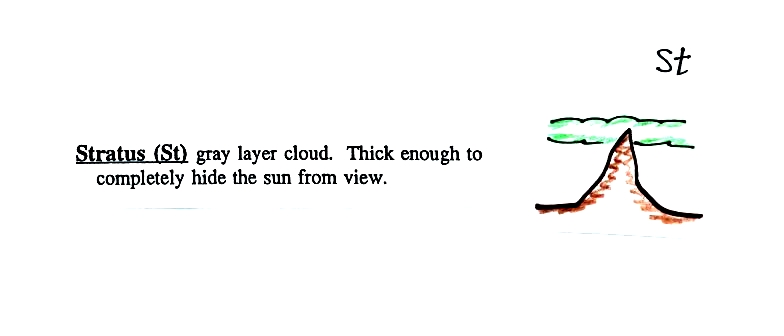
I didn't have any photos of stratus
clouds :(
Cumulus clouds
come
with different
degrees of vertical development. The fair weather cumulus clouds
don't
grow much vertically at all. A cumulus congestus
cloud is an intermediate stage between fair weather cumulus and a
thunderstorm.
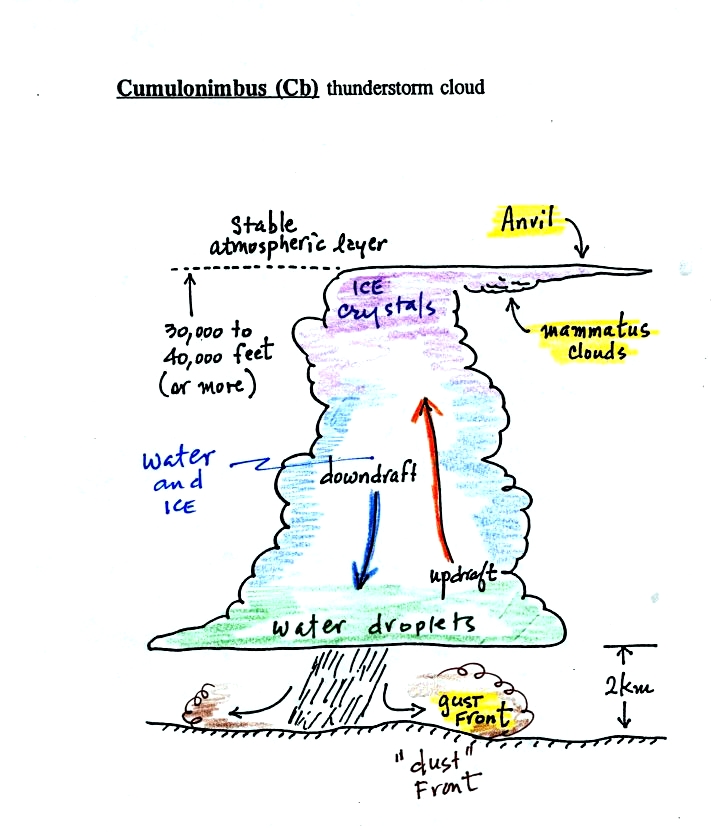
There are lots of
distinctive
features on cumulonimbus clouds including the flat anvil top and the
lumpy mammatus clouds sometimes found on
the underside of the
anvil. Cold dense downdraft winds hit the ground below a
thunderstorm and
spread out horizontally underneath the cloud. The leading edge of
these
winds produces a gust front (dust front might be a little more
descriptive).
Winds at the ground below a thunderstorm can exceed 100 MPH, stronger
than many
tornadoes. The top of a thunderstorm is cold enough that it will
be
composed of just ice crystals. The bottom is composed of water
droplets. In the middle of the cloud both water droplets and ice
crystals
exist together at temperatures below freezing (the water droplets have
a hard
time freezing). Water and ice can also be found together in
nimbostratus
clouds. We will see that this mixed phase region of the cloud is
important
for precipitation formation. It is also where the electricity
that
produces lightning is generated.
Here's one final feature to look for at the bottom of a
thunderstorm.

Cold air spilling
out
of the base
of a thunderstorm is just beginning to move outward from the bottom
center of
the
storm in the picture at left. In the picture at right the
cold air
has moved further outward and has begun to get in the way of the
updraft.
The updraft is forced to rise earlier and a little ways away from the
center of
the thunderstorm. Note how this rising air has formed an extra
lip of
cloud. This is called a shelf cloud.
Here's the
completed cloud chart.
